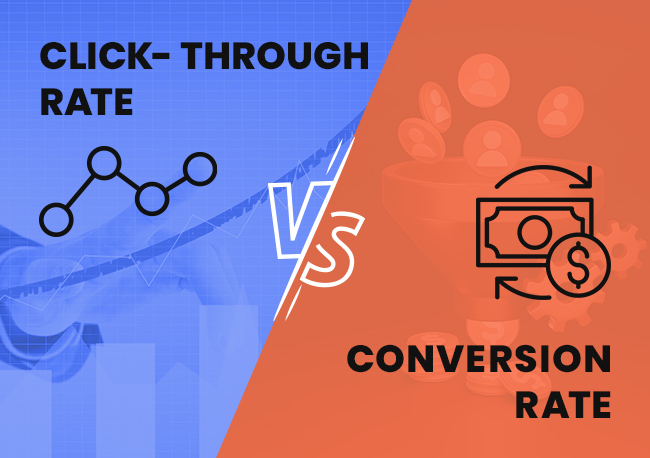| Getting your Trinity Audio player ready... |
Marketing campaigns are like puzzles, and understanding the pieces that make up the bigger picture is crucial for success. Two essential puzzle pieces in marketing are Click-Through Rate (CTR) and Conversions (CR).
In this article, we’ll delve into what these metrics mean, highlight their differences, emphasize their importance, and offer some tips on how to boost them. So, let’s get started on the exciting journey of decoding CTR and CR!
What is the Click-through Rate?
A click-through rate (CTR) is a metric used in advertising and marketing to measure the success of a digital campaign. This metric represents the total percentage of users who click on your advertisement compared to the total number of people it was shown to.
CTR is a vital performance indicator for advertisers. It helps them evaluate online campaigns’ success and make the needed changes. A higher CTR might indicate that the ad is popular among the audience and performs well. At the same time, a lower CTR suggests that the content may not be engaging enough.
Also Read: A Complete SEO Strategy Guide For New Websites
➢ How to Calculate Click-Through Rate (CTR)?
By calculating the Click-Through Rate (CTR), you can determine the ratio of users who clicked on it to the total number of users who viewed it. CTR is usually expressed in percentages, so multiply it by 100.
To calculate CTR, just divide the total number of clicks by the total number of impressions.
| CTR = (Clicks / Impressions) * 100 |
An example will help us better comprehend it. If you have 100 clicks and 1,000 impressions,
CTR = (100 / 1000) * 100 = 10%.
Remember that CTR is just one metric to assess the success of your content. Consider conversion rates, engagement metrics, and other relevant performance indicators depending on your goals.
➢ Importance of Click-Through Rate
1. Helps in Performance Measurement
CTR easily allows advertisers to measure the performance of their content and ads. It helps them identify the weak spots and errors in the strategy. Ultimately helping them to take actions that resonate closely with their target.
2. Effectiveness of Ads
For advertisers, CTR provides insight into the effectiveness of their ad campaigns. A low CTR may indicate that the ad’s messaging or visuals need improvement. In comparison, a high CTR suggests that the ad is resonating with the audience.
3. Relevance & Quality
Search engines and social media platforms often use CTR as a signal to determine the relevance and quality of content. The content addresses users’ needs and interests if a search result or post receives a high CTR.
4. Ad Placement and Positioning
CTR helps advertisers identify which ad placements or positions on a webpage or app are more likely to attract user attention and generate clicks. This information is valuable for optimizing ad placement strategies.
Also Read: Top Industries That Can Benefit From SEO?
➢ Factors Influencing Click-Through Rate (CTR) in Organic and Paid Advertising
1. Title and Meta Description
The title and meta description of your organic search result play a significant role in influencing CTR. A compelling, relevant, and well-optimized title and description can encourage users to click on your link. Make sure to keep them relevant and updated.
2. Search Result Position
Higher-ranking search results tend to have higher CTRs. Users often click on the first few results, so optimizing your website for better search engine rankings can lead to increased CTR.
3. Rich Snippets
Consider utilizing rich snippets like star ratings, review counts, images, and other structured data. Because it can make your organic search result stand out, increasing the likelihood of clicks.
4. URL Structure
A clean and descriptive URL can make it easier for users to understand what the page is about. It can help to increase clicks. Always make sure to keep the URL structure as clean as possible.
5. Content Quality
High-quality, relevant, and engaging content is more likely to attract clicks. The more your content addresses users’ needs and questions, the higher the CTR. Investing in high-quality content increases the likelihood of a promising campaign.
Also Read: Can I Blog To Improve The SEO Of Website?
| Paid Advertising |
1. Ad Copy Relevance
The ad copy should align with the user’s search intent. A well-crafted ad that directly addresses the user’s query is more likely to generate clicks. Relevancy is the key here for high-performing ads.
2. Keywords
Selecting relevant keywords and incorporating them into your ad copy is crucial. Users are likely to click on ads containing the keywords they searched for. Make sure to conduct thorough keyword research before carefully picking the right ones.
3. Ad Extensions
Utilizing ad extensions like site link extensions, callout extensions, and structured snippets can provide additional information and increase the visibility of your ad, leading to higher CTR.
4. Ad Position
Higher ad positions generally lead to higher CTRs. Ads displayed at the top of the search results page tend to receive more clicks. It is better to look into this matter because the positioned ads might not perform as expected.
5. Ad Visuals
For display and social media ads, visuals like images or videos can capture users’ attention and encourage clicks. Brainstorm and plan to determine what type of visual will work best for your ads and brand.
Also Read: How Is Ranking Different When Comparing PPC Vs SEO?
What is the Conversion Rate?
A conversion rate is also an important metric of business and marketing, just like a click-through rate. It refers to the percentage of people who take a desired action out of the total audience interacting with the campaign.
Conversion is all about turning a potential customer into an actual customer with these actions:
- Making a purchase
- Signing up for a newsletter
- Filling out a contact form
- Calling for more information
- Registering for an event
- Subscribing to a service
Also Read: Which Businesses Benefits From Local SEO Practices?
➢ How to Calculate Conversion Rate?
Figuring out the conversion rate is important as it can help determine whether the campaign was hit. Calculating the conversion rate is a piece of cake; the following formula will help you.
All you have to do is divide the total number of users who took the desired action by the total number of viewers.
Here’s a simple formula:
| Conversion Rate(%) = Number of Conversions/Total Number of Visitors x 100 |
- Count how many people completed your desired action (e.g., made a purchase).
- Divide that number by the total number of visitors to your website, page, or campaign.
- Multiply the result by 100 to express it as a percentage.
For example, if 1000 people bought your product out of 10000 audiences, then your conversion rate would be (1000 / 10000) x 100 = 10%
Importance of Conversion Rate
1. Optimizing User Experience
A low conversion rate could indicate that there are issues with your website or user experience that are hindering conversions. By analyzing the conversion rate, you can identify areas for improvement and make necessary changes to enhance user experience.
2. ROI Measurement
Conversion rate is key in determining your marketing efforts’ return on investment (ROI). It helps you understand how much value you’re getting from your investments and whether the resources you put into your campaigns translate into actual results.
3. A/B Testing
Conversion rate is often used in A/B testing, where different versions of a webpage or campaign are compared. To determine which performs better in terms of conversion. This testing helps optimize elements like headlines, images, call-to-action buttons, and more.
4. Competitive Analysis
Comparing your conversion rates with your competitors can provide valuable insights, especially into your market position and areas where you might need to catch up or differentiate yourself. Knowing what your competitors are up to can help you put in more relevant efforts.
Also Read: What Is The Importance Of SEO For eCommerce Website
Factors Influencing Conversion Rate in Organic and Paid Advertising
| Organic |
1. Quality of Content
The content’s relevance, usefulness, and engagement level play a significant role in driving conversions. High-quality content that addresses user needs and provides value is more likely to lead to conversions.
2. Target Audience
Understanding your target audience’s preferences, needs, and pain points helps in creating content. Because you can create content that resonates with them, increasing the likelihood of conversions.
3. SEO (Search Engine Optimization)
Properly optimized & organized content on your website that ranks well in search engines can drive organic traffic. The more visible your content is, the higher the chances of attracting users who are genuinely interested in your offer.
4. User Experience (UX)
A well-designed and user-friendly website or landing page enhances the user experience. Thus making it easier for visitors to navigate, find information, and take desired actions. You can’t ignore the mobile users as well. For that, you require a mobile-friendly website for a better user experience.
5. Social Proof
Positive reviews, testimonials, and user-generated content can build trust and influence visitors to convert as they see evidence of others’ positive experiences. Consider building your social reputation for better results.
Also Read: Digital Marketing Strategies For Catering Business
| Paid Advertising |
1. Ad Relevance
The alignment between the ad content, keywords, and landing page is crucial. A relevant ad experience ensures that users find what they expect after clicking.
2. Ad Copy and Design
Attention-grabbing ad copy and visually appealing design can capture users’ interest. Moreover, it encourages them to click through to the landing page. Don’t forget to create an appealing ad copy and visuals.
3. Targeting
Precise audience targeting based on demographics, interests, behavior, and location increases the likelihood of reaching users who are more likely to convert.
4. Ad Placement
The placement of ads on relevant websites, social media platforms, or search engine results pages can impact the visibility and effectiveness of your ads.
5. Landing Page Quality
A well-optimized landing page with a clear value proposition, engaging content, and intuitive design can improve user engagement and conversion rates.
6. Ad Extensions
Utilizing ad extensions, such as site link extensions or call extensions, can provide additional information and options for users to engage with your ads.
7. Bid Strategy
Your bidding strategy (e.g., cost-per-click, cost-per-impression) can affect the number of clicks or impressions you receive. That, in turn, can impact conversions.
How Can You Optimize CTR and CR in Organic Efforts?
➢ Call to Action (CTA)
Use clear and persuasive CTAs in your content to guide users toward the desired action. Make sure CTAs are relevant to the content and user intent. CTAs might have a small role, but they play a big impact.
➢ Conversion Rate Optimization (CRO)
Continuously analyze your conversion funnel and identify areas where users drop off. A/B test landing pages, forms, and checkout processes to improve conversion rates.
➢ Activate Breadcrumb Navigation
Breadcrumb navigation can be a valuable tool for optimizing Click-Through Rate (CTR) and Conversion Rate (CR) in your organic efforts, particularly for websites with a hierarchical structure like eCommerce websites or content-rich blogs. Breadcrumb navigation provides users a clear path to navigate your site, improving user experience and boosting CTR and CR.
Implementing and optimizing breadcrumb navigation in your organic efforts can enhance the user experience, increase CTR, and improve CR. Remember that user satisfaction and relevance should always be at the forefront of your optimization efforts, as these factors play a significant role in achieving your goals.
➢ Leverage Google Analytics Reports
Optimizing Click-Through Rate (CTR) and Conversion Rate (CR) in organic efforts through Google Analytics reports requires a strategic approach.
Regularly reviewing SEO tools like Google Analytics reports and making data-driven optimizations is essential to achieve long-term success.
Additionally, keep in mind that SEO and user experience go hand-in-hand, so focus on creating valuable, user-friendly content to drive higher conversions.
Also Read: What Should You Consider When Developing Website Content?
How Can You Optimize CTR and CR in Paid Advertising?
➢ Use Negative Keywords
Negative keywords are essential in paid advertising to improve Click-Through Rate (CTR) and Conversion Rate (CR). By excluding irrelevant terms, you ensure a more qualified audience sees your ads. This will increase the chances of clicks and conversions while reducing wasted spend.
➢ Narrow your audience targeting
To optimize Click-Through Rate (CTR) and Conversion Rate (CR) in paid advertising. Refine your audience targeting by analyzing data and segmenting based on demographics, behaviors, and interests by crafting tailored ad content that resonates with each segment’s needs and preferences.
➢ Increase Bids on Keywords
To optimize Click-Through Rate (CTR) and Conversion Rate (CR) in paid advertising. Increase bids on keywords, yielding profitable conversions. This strategy boosts visibility for high-performing keywords, attracting more clicks and maintaining conversion efficiency.
➢ Evoke Emotions
In paid advertising, one can evoke emotions through compelling visuals and persuasive copy to boost Click-Through Rates (CTR) and Conversion Rates (CR). Emotional resonance drives engagement and conversion, delivering impactful results for your campaigns.
Click-Through Rate vs Conversion Rate: What’s the Relationship Between the Metrics?
- CTR and CR are related because CTR represents the initial engagement with an ad or link. In contrast, CR measures the subsequent actions taken by users after clicking.
- A high CTR indicates that a significant number of people are interested enough to click on the ad or link. This can potentially lead to higher conversion rates.
- However, a high CTR does not guarantee a high CR. The quality of the landing page, the relevance of the offer, and the overall user experience on the website play crucial roles in converting clicks into conversions.
- It’s essential to analyze CTR and CR together to get a complete picture of the effectiveness of a marketing campaign. A high CTR with a low CR may suggest issues with the post-click experience.
Whereas a low CTR with a high CR might indicate that the targeting is precise, the ad creative needs improvement.
Also Read: 15 Best SEO Audit Tools For Your Website (Free+Paid)
Click Through Rate vs Conversion Rate: Which Matters More?
Click Rate (CTR) and Conversion Rate are important metrics in digital marketing. However, they serve different purposes and are relevant at different customer journey stages.
CTR measures the percentage of people who click on your ad or website link after seeing it. It’s like counting how many people enter a store after passing by its entrance. A high CTR indicates that your ad or content attracts attention and drives traffic to your website.
Conversion Rate, on the other hand, tells you how many of those visitors take the desired action. For example, making a purchase, signing up, or filling out a form. It’s akin to tracking how many store visitors buy something. A high Conversion Rate indicates that your website successfully converts visitors into clients.
So, which matters more depends on your goals. CTR matters more if you’re focused on getting many people to your website. But if your primary goal is to turn those visitors into customers, then Conversion Rate takes the spotlight.
Ideally, you want a balance – a good CTR to bring in visitors and a strong Conversion Rate to turn those visitors into valuable customers.
Also Read: Does SSL Help SEO? Discover Eye-Opening Insights
Conclusion
It is common to get confused between these key metrics, even for an experienced professional. Hopefully, this article helped you learn every important detail about CTR and CR. Closely monitoring these metrics allows one to execute successful and result-driven marketing campaigns!




